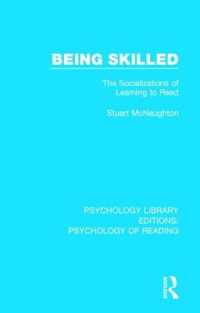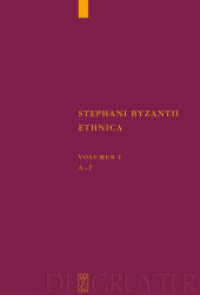- ホーム
- > 洋書
- > 英文書
- > Psychology
Full Description
Virginia Volterra and Carol Erting have made an important contribu tion to knowledge with this selection of studies on language acquisi tion. Collections of studies clustered more or less closely around a topic are plentiful, but this one is 1 nique. Volterra and Erting had a clear plan in mind when making their selection. Taken together, the studies make the case that language is inseparable from human inter action and communication and, especially in infancy, as much a matter of gestural as of vocal behavior. The editors have arranged the papers in five coherent sections and written an introduction to each section in addition to the expected general introduction and conclu sion. No introductory course in child and language development will be complete without this book. Presenting successively studies of hearing children acquiring speech languages, of deaf children acquiring sign languages, of hear ing children of deaf parents, of deaf children of hearing parents, and of hearing children compared with deaf children, Volterra and Erting give one a wider than usual view oflanguage acquisition. It is a view that would have been impossible not many years ago - when the primary languages of deaf adults had received neither recognition nor respect.
Contents
I Hearing Children with Spoken Language Input.- 1 Social and Cognitive Determinants of Mutual Gaze Between Mother and Infant.- 2 Gestural Development, Dual-Directional Signaling, and the Transition to Words.- 3 Gestures, Words, and Early Object Sharing.- 4 Some Observations on the Origins of the Pointing Gesture.- 5 Communicative Gestures and First Words.- 6 Sign Language Among Hearing Infants: The Spontaneous Development of Symbolic Gestures.- 7 Vocal and Gestural Symbols: Similarities and Differences from 13 to 28 Months.- II Deaf Children with Sign Language Input.- 8 The Interactional Context of Deaf Mother-Infant Communication.- 9 Acquisition of the Handshape in American Sign Language: A Preliminary Analysis.- 10 Faces: The Relationship Between Language and Affect.- 11 The Early Development of Deixis in American Sign Language: What Is the Point?.- 12 The Transition from Gesture to Symbol in American Sign Language.- III Deaf Children Without Sign Language Input.- 13 The Development of Morphology Without a Conventional Language Model.- 14 Gesture in Hearing Mother-Deaf Child Interaction.- 15 The Interaction of Gesture and Speech in the Language Development of Two Profoundly Deaf Children.- 16 How Does Gestural Communication Become Language?.- IV Hearing Children with Spoken and Sign Language Input.- 17 Early Sign Language Acquisition: Implications for Theories of Language Acquisition.- 18 Emergence of Mode-Finding and Mode-Switching in a Hearing Child of Deaf Parents.- V Hearing Children and Deaf Children Compared.- 19 Gesture in Early Child Language.- 20 From Communication to Language in Hearing and Deaf Children.- 21 Enhancement of Spatial Cognition in Deaf Children.- Conclusion.- References.







